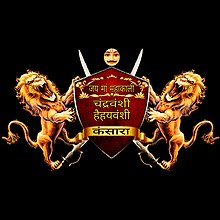Kansara
The Kansara is a Hindu community found throughout India. They are mostly found in Gujarat, Rajasthan, and Maharashtra. Also found in Madhya Pradesh, Uttar Pradesh, Chhattisgarh, and Jharkhand.
 The Great Coat of Arms of Kansara | |
| Regions with significant populations | |
|---|---|
| India | |
| Languages | |
| Hindi, Gujarati, Marathi | |
| Religion | |
| Hinduism | |
| Related ethnic groups | |
| Tambat, Thathera, Kasera |
According to Varna, they come under Kshatriya varna. They can be also known as kings and warriors. They are known as Chandravanshi Haihayavanshi Kshatriya (चंद्रवंशी हैहयवंशी क्षत्रिय).
Their Kuldevi is Mahakali Mata. Their main pilgrimage places are Pavagadh in Gujarat, a temple of Mahakali Mata, and Mahishmati in Madhya Pradesh, an erstwhile kingdom of Raj Rajeshwar Chakravarti Samrat Kartavirya Sahasrabahu Arjun Maharaj. They also visit to the Nathdwara (Shrinathji) or Shree Lalvadrayji (LALJI – BHIYAL) Junagadh District of Saurashta and ""Futda Temple"".
Etymology
The Kansara derived their name from kan̩su (Gujarati: કાંસુ, IPA: [kɑɳsũː]), bell metal.[1]
History
Their mythical history associates them with Parshurama (sixth avatar of Vishnu) who exterminated the Kshatriyas. It is said that the Kansaras were Kshatriyas who hid their identity by selling utensils to save their lives. Later, selling utensils became their caste occupation. This story is told in the Kalika Purana, named after their deity Kali.[1]
Festivals
They celebrate all Hindu festivals, though Navaratri and Vijayadashami are the main. They arrange many cultural functions during nine days of Navaratri and Ayudha Puja or Shastra puja, i.e., worship of weapons that takes place on the ninth day of the Navaratri festival. Weapons are retrieved for use with the blessings of the Goddess on the tenth day, Vijayadashami. Other important festivals are Diwali, Raksha Bandhan, Makar Sankranti, Kartik Ekadashi, Nagpanchami and Sahastrarjun Jayanti.
Caste groups
The Kansara belongs to Gujarat, India. Their associated groups live in Maharashtra such as Tambat.[2]
The Kansara are divided into Gujarati Kansara, Maru Kansara, Sorathia Kansara, and Jamnagari Kansara, Surti Kansara, based on their native place. The Gujarati Kansara live in Wadhwan, Surendranagar, Rajkot, Bhavnagar, and Dhrangdhra. They speak the Kathiawar dialect of Gujarati. They traditionally wear kanthi mala.[1]
In other states, there is no concentration of the people in any particular region and can be found in almost all the places.
People living in Gujarat and Maharashtra are vegetarian.[1][2] People living in other places have mixed eating habits.
References
- Gujarat. Popular Prakashan. 2003. pp. 599–600. ISBN 978-81-7991-104-4.
- B. V. Bhanu (2004). People of India: Maharashtra. Popular Prakashan. pp. 929–930. ISBN 978-81-7991-101-3.